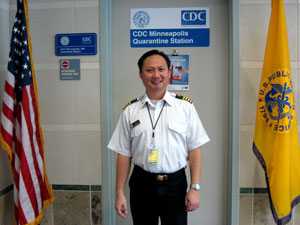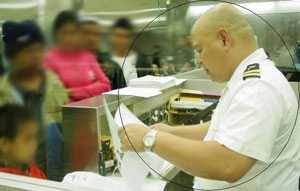How CDC's Quarantine Stations Welcome New Arrivals to the United States and Protect the Health of U.S. Communities
With 1 billion people crossing international borders each year, there is nowhere in the world from which we are remote and no one from whom we are disconnected. That is why the U.S. Centers for Disease Control and Prevention’s (CDC) Quarantine Stations, often called Q-stations, are so important. U.S. Quarantine Stations are part of a broad system that serves to limit the introduction and spread of infectious diseases into the United States.

Arnold Vang at the Minneapolis Q-Station
U.S. Quarantine Stations are located at airports and land-border crossings where 85% of international travelers arrive. They are staffed with quarantine medical and public health officers from CDC. These health officers decide whether ill persons can enter the United States and what measures should be taken to prevent the spread of infectious diseases. Quarantine officers are responsible for many activities, including responding to reports of illnesses, examining cargo, inspecting animals and animal products, and monitoring the health and collecting medical information of new immigrants, refugees, asylees, and parolees. To find out more about CDC’s quarantine stations, please visit www.cdc.gov/quarantine.
Through their understanding of the sensitive circumstances faced by immigrants and refugees, and the challenges encountered these individuals before arriving in the United States, Q-station officers are uniquely equipped to handle many of the obstacles immigrants and refugees face.
An Officer and a Refugee
Arnold Vang is one of the CDC’s quarantine officers at the Minneapolis-St. Paul Quarantine Station, and he knows firsthand what it is like to be a refugee. Arnold, along with some of his family, came to the United States in 1976 from Laos.
“It was dangerous for us to stay in Laos because my father had worked with the United States. When the country fell to the communists, we knew we had to leave.”
With just the clothes on their backs, Arnold and his family left in the middle of the night, got into a small boat, and crossed into Thailand. They took refuge at a Buddhist temple, where they were picked up by the United States military personnel and moved to a military base. A year later, Arnold and his family moved to a camp with 100,000 refugees. They were given pots and pans, but had no water or wood. Food was scarce and crime was rampant.
Eventually, Arnold and his family were chosen to come to the United States. They arrived not knowing how to use the stove or the thermostat, and they woke up to a new world on the morning of their arrival when they saw their first snow.
“My experience as a refugee made me want to work in public health, especially with refugees. A lot of refugees are silent out of fear and are afraid to talk about health issues,” Arnold says. “It’s important to inquire but also to be respectful.”
Arnold feels very fortunate to have been chosen to come to the United States. He was the first person in his family to go to high school and college. Every day at work, Arnold expresses his gratitude, “If I can make the transition easier, then I’ve done something to help a refugee.” Having people in place at Q-stations who understand and respect the many emotions, challenges, and transitions experienced by refugees and immigrants helps facilitate the work that CDC must do to welcome these new arrivals and protect the health of U.S. communities.
Working with Immigrants and Refugees
Each year, close to 75,000 refugees and 500,000 immigrants come to the United States from around the world. When immigrants and refugees arrive in the United States, they are sometimes met by CDC’s quarantine officers, or their medical documents are referred to a quarantine officer by U.S. Customs and Border Protection Officers when public health follow-up is required. This is particularly important for newly arriving refugees and immigrants, who often experience a higher burden of disease than U.S.-born populations. For example, tuberculosis (TB) rates in foreign-born persons remain higher than those in the U.S.-born population. From 1990 through 2010, the percentage of TB cases occurring in foreign-born persons increased from 26% to 60%.

Perry Camagong, Quarantine Officer at the Los Angeles Quarantine Station, processing immigrant paperwork
In addition to their activities at Q-stations, officers also serve a vital role in promoting the health of refugees and immigrants, while protecting the health of U.S. communities. Q-station officers notify state and local health departments in the areas where refugees and immigrants resettle about any health issues that need follow-up care. One example is the Chicago Quarantine Station’s referral program for arriving immigrants with TB conditions. Q-station officers counsel refugees and immigrants with infectious TB and other communicable diseases on the importance of follow-up medical treatment and provide them with referrals and linkages to state and local health departments. An evaluation of this program demonstrated a 400% increase for refugees and immigrants starting medical follow-up and improved timeliness in getting to a state or local health department. As a result, a standard referral program is being developed for all entry points into the United States.
CDC’s quarantine officers take their role very seriously and want to make sure all migrants have a positive experience. For someone new to this country, it can often be frightening. Because of the experiences they had prior to arriving in the United States, they may fear government officials and people in uniforms. Some immigrants and refugees may never have flown on an airplane before, and the clothing, language, and food may all be new and different. John Bateman, quarantine officer at the Newark Quarantine Station says, “in addition to protecting our public health, I think it is my duty to make the process as comfortable and stress free as possible.”
Quarantine officers also work closely with volunteer organizations, along with airport, federal, and local partners. Volunteer organizations often ensure that refugees get the help they need, including jobs and education. Local health departments ensure immigrants and refugees have necessary follow-up health care. To find out more about immigrant and refugee health, please visit www.cdc.gov/immigrantrefugeehealth.
As U.S. demographics change and new public health needs emerge, the CDC’s quarantine officers are determined to welcome new arrivals, while also protecting the public’s health.
- Page last reviewed: December 23, 2016
- Page last updated: December 23, 2016
- Content source:


 ShareCompartir
ShareCompartir